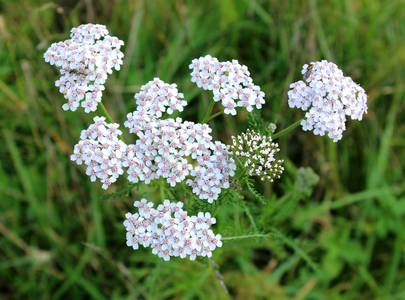Utilisation

Both yarrow herb, consisting of the dried, flowering shoot tips, and yarrow flowers, consisting of the dried inflorescences of the yarrow, are used pharmaceutically for medicinal purposes. The drug is an ingredient in numerous tea blends and ready-to-use medicines.
In laboratory studies, yarrow has shown a variety of effects, such as anti-inflammatory, antispasmodic, antimicrobial and antifungal properties, and it also promotes the flow of bile.
Yarrow has an aromatic, bitter flavour, which is why, like chamomile flowers, it is used to treat loss of appetite and digestive disorders, such as mild cramp-like complaints in the gastrointestinal tract. Traditional medicine has also documented its use for mild cramps associated with menstruation and for superficial wounds.
In addition to the essential oil (the composition varies depending on the yarrow variety, important components are β-pinene, sabinene, 1,8-cineole, camphor, β-caryophyllene, germacrene D), sesquiterpene lactones (achillicin), germacranolides, polyacetylenes, flavonoids and phenolcarboxylic acids. Azulenes (substances that colour the distilled essential oil blue) are also not found in all varieties of yarrow.
Care should be taken when using them, as representatives of some yarrow species can trigger allergies.
Botany
Yarrow or common yarrow (Achillea millefolium L. in the broader sense) is a collective species in which species with different chromosome sets, different appearances and different constituents are grouped together. The perennial herb from the composite family grows up to 80 cm high.
The common yarrow has typically two to three-pinnate leaves with several pairs of leaflets.
The individual flower heads with their bright white to pink-coloured ray florets are also grouped together in an umbel to make them even more attractive to pollinators. Flowering time is from July to October.
Distribution
Of the 130 species of yarrow known worldwide, around 60 are found in Europe and 22 of them in Austria. The common yarrow is native to the whole of Europe and is mainly found in Central and Northern Europe, North America and Asia. It prefers to grow on sunny, nitrogen-rich, fresh to dry loamy soils, on meadows and roadsides in colline (flat to hilly) to montane, sometimes subalpine altitudes.
It reproduces both by seed and vegetatively by runners. In the wild, the up to 2 mm long, elongated, wedge-shaped, shiny silver-grey seeds are dispersed by the wind or ants. The seeds can be harvested from August to October and sown directly.
Service
The preservation of diversity is very important to us, which is why we store around 5,400 samples of seeds and plants in our gene bank . With the gene bank for agricultural crops, medicinal and aromatic plants, we are making a significant contribution to the preservation of biodiversity.
Last updated: 28.08.2025
automatically translated